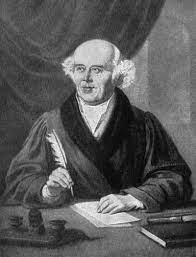Samuel Hahnemann, (1755-1843) a German physician, developed one of the ideas originally put forward by Hippocrates; that there is a relationship between disease and the medicines that are used to cure them. In homeopathic philosophy, an illness changes the whole economy of an individual ; not by physical symptoms alone, the mental and emotional state is altered too, it is “as if the person is possessed by the disease ”

Hahnemann suggested that medicines produce an “artificial disease” in the economy of an individual, lasting only as long as the presence of the medicine in the system, and that he could use this aspect of the medicine to “fool the body” into thinking it was under a bigger threat than it actually was, so making the defense mechanisms within the body work harder. Of course when the artificial disease (medicine) wore off, the defense mechanisms of the body, having been so stimulated, could overcome the “real problem”, the original complaint.
Samuel Hahnemann realised that it was ridiculous to test the effects of potential medicines for the treatment of human diseases on any thing other than humans, but being aware of the potentially lethal effects of pharmaceutical products, he came upon a process he called “ dynamization & potentization”, in which the actual physical effects of a proposed medicinal agent were attenuated by dilution, whilst still harnessing their inherent potential to bring about positive change.
He postulated that in order to know the true healing effects of these “potentized remedies” on the sick, they must first be tried on Healthy subjects, in order to know which symptoms they could produce, and to this end he set about using members of his own family as guinea pigs.
Using animal, vegetable and mineral substances available to him at that time, he compiled, from the “proving symptoms” developed by his test subjects, a “materia medica” of homeopathic medicines and their particular characteristic symptoms, that he used to treat disease.
Because of the method of potentization and dynamization that he employed in making homeopathic medicines, many of the most poisonous and deadly substances known to mankind have been found to be some of the most effective homeopathic remedies; even more surprising maybe is the fact that some apparently innocuous materials with no observable physical effects when used in material dosage , have proven to have great healing capability when prepared in homeopathic potency.
The homeopathic consultation lasts up to about 2 hours, during which time the patient is encouraged to talk about all aspects of their life, not just their problem, so a picture can be built up of the person, both in health and disease, in order to more precisely find out the way in which the disease characteristically alters their perception.
A homeopathic medicine is chosen from the 2000 or so available, which the practitioner believes most accurately reflects the characteristic symptoms of the diseased individual.
Although it is not necessary for a good prescription, a perceived worsening of the presenting symptoms for a short period of time, is generally taken as a good omen, matching as it does Samuel Hahnemann’s idea that the body is being fooled into thinking things are becoming worse, and is often followed by lessening of symptoms and return to health.

